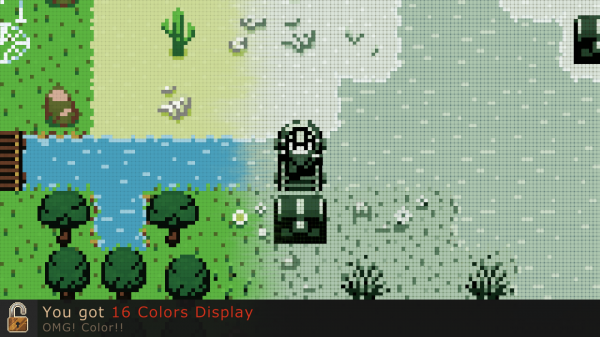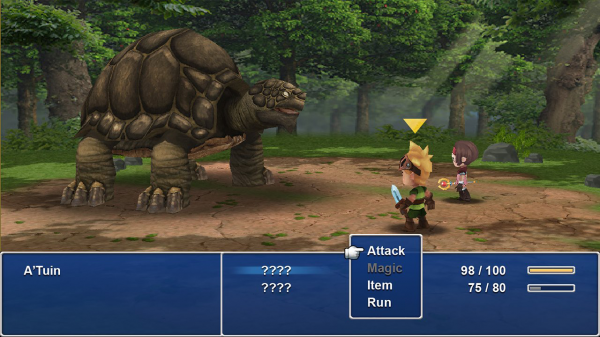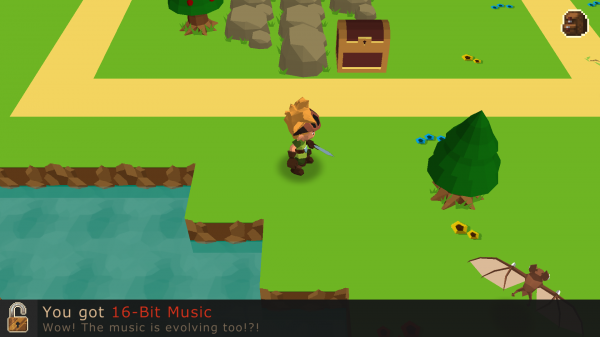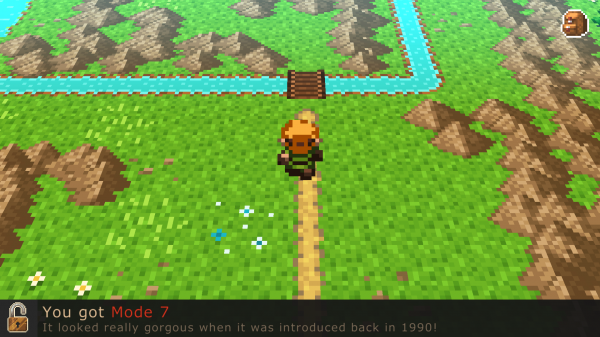
Evoland PC Review
Evoland started off as a small concept game built in only 48 hours by just one person for the Ludum Dare competition. After winning the competition out of 1,400 other games, Evoland attracted quite a crowd and, due to the great reception and positive feedback from fans, was developed into a full title that was recently greenlit on Steam. The original concept that won Ludum Dare #24 is still available to play from Shiro Games’ website and basically acts as a small demo for the real game, as it starts off very similarly and introduces the idea behind Evoland. Acting as a playable guide through the history of RPGs, Evoland is constantly changing and updating as users progress, with each new enhancement showing how RPGs have evolved over the years.
Much like DLC Quest, players must unlock new features as they go, which can range from something as important as being able to move left, or something as insignificant as unlocking place names – although, you are not required to purchase your way through the game but instead must open frequent chests that contain tiny improvements. With each new unlock often allowing the player to progress onto the next area, there’s usually a clever blockage of some kind forcing you to first find the required chest. For example, at the beginning you are locked onto a grid like early top-down games and can’t make your way past a few rocks due to their position until you unlock ‘free movement’, allowing you to break off of the grid and pass by with no problems.
There are a number of different types of RPGs, and Evoland shows many of them. You start by playing a top-down adventure game very similar to the original Legend of Zelda and then move onto a Final Fantasy-style, turn-based fighting system with random encounters. At one point, you even get to experience a hack-and-slash, Diablo-esque area full of money and loot drops. You don’t complete one RPG style at a time and move on, but instead bounce between them all throughout the game, each time unlocking a bunch of new modifications and mixing up gameplay. The game both honours its obvious inspirations and also pokes fun at the same time, such as when encountering random battles every few steps of a journey – a common joke of the classic Final Fantasy and Dragon Quest games. There’s also a small mission that requires you to run back and forth inside a town, talking to different NPCs, which is purposely annoying and again parodies many classics. It’s charming and entertaining to experience these over-exaggerations and it never takes away from the game itself.
The story (that also has to be unlocked) is extremely brief and is told in the space of just a few lines of text. There is a final villain that you must defeat, but he is introduced late in the game and shares a very rushed back-story, and all in all is pretty shallow. It’s odd for an RPG game to not have a deep, enthralling tale to tell and its share of dark pasts, but here I really didn’t mind. The game is a story in itself that leads the player through the ages of RPGs and nothing is lost in the quick narration that the game uses as a bare minimum reason to keep the player going. Evoland only takes several hours to complete, even if you find all the hidden areas and collectibles, which I also didn’t mind as it’s clearly a concentrated experience that focuses on gameplay instead of length. The game could easily be adapted into a full 100-hour RPG, but it just wouldn’t be the same enjoyable nostalgia-fest that Evoland succeeds at being.
A short while into the game, you are forced to save a girl who has fainted during battle, instantly joining your party and asks for your help in her quest to find a magic crystal. By the way, her name is Kaeris – or as I like to call her, K-Aeris. She even looks similar to the Final Fantasy character with her pink dress and staff. The similarities don’t end here, either. You’ll find the “legendary sword”, which is clearly Cloud’s infamous Buster sword (but much, much shorter), and even run into a character named Sid, who just happens to own an airship that looks exactly like the Highwind. There are a number of other references too, including a great Dragon Ball Z joke and the use of a card game almost identical to Final Fantasy VIII‘s Triple Triad. Even the music is incredibly close to several popular Final Fantasy tunes and there’s a number of Zelda sounds used too, such as the distinct chest opening melody. The use of so many associations may seem like the game is a complete rip-off, but that couldn’t be farther from the truth. Evoland proves itself to be its own unique game that was created by a team of gamers simply respecting some beloved titles.
When you do find the magic crystal and activate its powers, the world becomes 3D for the first time and a whole new style of gameplay begins. You won’t just be going around fighting enemies but will also have to solve a number of puzzles that vary from simply walking along a path of tiles in one continuous line, to jumping between 2D and 3D to get around obstacles and take out blockages. For example, you must be in 3D to walk over small walls that look huge in the 2D world, and you must be in 2D to move past small trees that are in your way in the 3D world. They’re never very difficult puzzles, but just getting to see the world switch between dimensions was fun enough and awed me every time.
As you move between styles of gameplay, you must fight in different ways, sometimes using a turn-based battle system and other times using an action-RPG style that more closely resembles the Zelda series. The enemies can often be annoying, as you can only hit many of them from the back or side but they follow you facing forward. This causes some awkward battles and the player taking a fair bit of damage – although, as you unlock other weapons, you’ll find that enemies have certain weaknesses and can easily be taken out with different attacks. The final boss fight is much different than anything you take on during the rest of the game and requires a bit of thinking and fast acting. It’s a fun battle but the ending is rather anti-climatic and as the credits begin to roll, you can’t help but feel you wanted just a little bit more.
Like many other games, there’s still a lot to do after the villain has been defeated and you are allowed to backtrack all you want, re-exploring old areas and stumbling upon new ones. Using newly collected items, such as the bomb, you can go back and blast holes in walls that you had to leave unexplored your first time through. Unfortunately, backtracking though all these areas can be quite annoying as your character is not too fast and there’s no speed increase unlock. There are quite a few hidden areas that mostly lead to chests full of stars and cards – the two different types of collectibles in the game. There are a total of 30 stars that don’t change anything when found and 23 cards that are added to your deck for when playing Double Twin, the Triple Triad clone. In the last town, there’s an NPC who offers you a game of Double Twin that starts off on Easy and works up to Champion difficulty. It’s a fun game but you aren’t rewarded anything for winning, which would have been welcomed.
Evoland is a one-time experience that I would recommend to any RPG fan. For the few hours you’re playing, you are reminded of why you play video games at all. It’s a great nostalgic feeling that constantly brought back memories of playing some of my favourite games as a child. It was clearly made by gamers who also have fond memories of the classic RPG titles that have come so far and adapted so much over the years, and Evoland doesn’t disappoint in commemorating them. RPGs are usually very long, and as many of us have grown up, we simply don’t have the time to play through them anymore, making Evoland an extraordinary journey through a much simpler time that won’t be forgotten anytime soon.




